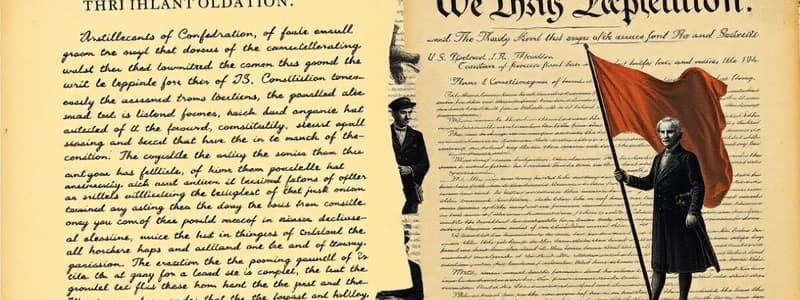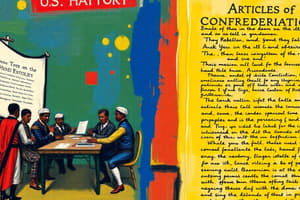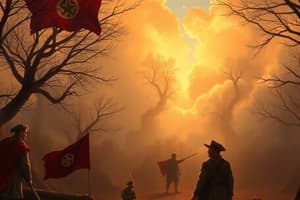Podcast
Questions and Answers
Which of the following was a significant weakness of the Articles of Confederation that led to its eventual replacement?
Which of the following was a significant weakness of the Articles of Confederation that led to its eventual replacement?
- The judicial branch had the authority to overturn state laws, causing conflicts and undermining state sovereignty.
- Amendments to the Articles required unanimous consent from all states, making it too easy to adapt to changing circumstances.
- The executive branch held too much power, leading to centralized control and potential abuse.
- The national government lacked the power to effectively tax and regulate interstate commerce, hindering its ability to address national debt and economic issues. (correct)
How did the Land Ordinance of 1785 and the Northwest Ordinance of 1787 contribute to the expansion and development of the United States?
How did the Land Ordinance of 1785 and the Northwest Ordinance of 1787 contribute to the expansion and development of the United States?
- They promoted economic growth by granting large tracts of land to wealthy individuals and corporations for resource extraction.
- They established policies that encouraged rapid, unregulated settlement of western lands, leading to conflicts with Native American tribes.
- They centralized control over western territories under the authority of the executive branch, limiting opportunities for local self-governance.
- They provided a framework for orderly settlement, the creation of new states, and the prohibition of slavery in the Northwest Territory. (correct)
What was the primary significance of Shay's Rebellion in highlighting the inadequacies of the Articles of Confederation?
What was the primary significance of Shay's Rebellion in highlighting the inadequacies of the Articles of Confederation?
- It exposed the vulnerability of a weak central government unable to effectively respond to internal unrest and economic grievances. (correct)
- It prompted Congress to immediately grant states greater autonomy in addressing economic and social issues.
- It demonstrated the effectiveness of the national government in suppressing domestic insurrections and maintaining order.
- It led to the immediate abolition of state militias and the establishment of a standing national army.
In what way did the Great Compromise resolve the debate over representation in the U.S. Congress during the Constitutional Convention?
In what way did the Great Compromise resolve the debate over representation in the U.S. Congress during the Constitutional Convention?
How did the Three-Fifths Compromise address the issue of slavery within the context of political representation?
How did the Three-Fifths Compromise address the issue of slavery within the context of political representation?
What limitations did the Commerce Compromise place on the power of Congress to regulate trade?
What limitations did the Commerce Compromise place on the power of Congress to regulate trade?
What was the relationship between the failure of the Articles of Confederation and the subsequent creation of the U.S. Constitution?
What was the relationship between the failure of the Articles of Confederation and the subsequent creation of the U.S. Constitution?
How did the Northwest Ordinance of 1787 address the issue of slavery in the newly formed territories?
How did the Northwest Ordinance of 1787 address the issue of slavery in the newly formed territories?
Which of the following describes the impact of the Bill of Rights?
Which of the following describes the impact of the Bill of Rights?
What was the main objective of Alexander Hamilton's economic plan during George Washington’s presidency?
What was the main objective of Alexander Hamilton's economic plan during George Washington’s presidency?
How did the Whiskey Rebellion demonstrate the power and authority of the early United States government under President Washington?
How did the Whiskey Rebellion demonstrate the power and authority of the early United States government under President Washington?
What was the primary reason behind President Washington's Neutrality Proclamation of 1793?
What was the primary reason behind President Washington's Neutrality Proclamation of 1793?
What was the significance of the XYZ Affair during John Adams’ presidency?
What was the significance of the XYZ Affair during John Adams’ presidency?
How did the Alien and Sedition Acts impact political discourse and individual liberties in the United States?
How did the Alien and Sedition Acts impact political discourse and individual liberties in the United States?
What principle was asserted in the Kentucky and Virginia Resolutions, written in response to the Alien and Sedition Acts?
What principle was asserted in the Kentucky and Virginia Resolutions, written in response to the Alien and Sedition Acts?
What was the most significant consequence of the Louisiana Purchase during Thomas Jefferson’s presidency?
What was the most significant consequence of the Louisiana Purchase during Thomas Jefferson’s presidency?
What legal principle was established by the Supreme Court case Marbury v. Madison (1803)?
What legal principle was established by the Supreme Court case Marbury v. Madison (1803)?
How did Jefferson's actions demonstrate a conflict between his philosophical beliefs and his presidential responsibilities?
How did Jefferson's actions demonstrate a conflict between his philosophical beliefs and his presidential responsibilities?
Flashcards
Articles of Confederation
Articles of Confederation
The first governing document of the U.S. created in 1781, establishing a weak central government.
Weak Central Government
Weak Central Government
A government with limited authority, where states retain most powers.
Land Ordinance of 1785
Land Ordinance of 1785
A law dividing western land into townships for orderly settlement and school provisions.
Northwest Ordinance of 1787
Northwest Ordinance of 1787
Signup and view all the flashcards
Shays's Rebellion
Shays's Rebellion
Signup and view all the flashcards
Constitutional Convention
Constitutional Convention
Signup and view all the flashcards
Great Compromise
Great Compromise
Signup and view all the flashcards
Three-Fifths Compromise
Three-Fifths Compromise
Signup and view all the flashcards
Checks and Balances
Checks and Balances
Signup and view all the flashcards
Bill of Rights
Bill of Rights
Signup and view all the flashcards
Washington's Cabinet
Washington's Cabinet
Signup and view all the flashcards
Hamilton’s Economic Plan
Hamilton’s Economic Plan
Signup and view all the flashcards
Whiskey Rebellion
Whiskey Rebellion
Signup and view all the flashcards
Neutrality Proclamation
Neutrality Proclamation
Signup and view all the flashcards
XYZ Affair
XYZ Affair
Signup and view all the flashcards
Alien and Sedition Acts
Alien and Sedition Acts
Signup and view all the flashcards
Marbury v. Madison
Marbury v. Madison
Signup and view all the flashcards
Study Notes
Chapter 1: The Articles of Confederation and the Need for a New Government
- The Articles of Confederation, established in 1781, created a weak central government.
- States held most power under the Articles.
- Congress could make laws, declare war, and print money, but couldn't tax, regulate trade, or enforce laws.
- Debt and inability to pay soldiers from the Revolution plagued the nation.
- Land Ordinance of 1785: Divided western land into townships for settlement, including some land for public schools.
- Northwest Ordinance of 1787: Set a process for new territories to become states and banned slavery in the Northwest Territory.
- Shays's Rebellion (1786-1787): Farmers led by Daniel Shays rebelled against high taxes and debt.
- The rebellion exposed the weakness of the Articles of Confederation, showing the national government's inability to maintain order.
Chapter 2: The Constitutional Convention and the U.S. Constitution
- In 1787, the Constitutional Convention met in Philadelphia to revise the Articles but instead created a new Constitution.
- Representation in Congress was a major issue, with large states favoring population-based representation and small states wanting equal votes.
- The Great Compromise established a two-house Congress: Senate (equal representation per state) and House of Representatives (representation based on population).
- The Three-Fifths Compromise counted enslaved people as three-fifths of a person for representation purposes.
- The Commerce Compromise allowed Congress to regulate trade but prohibited taxes on exports and restricted interference with the slave trade for 20 years.
- Checks and Balances were built into the Constitution to prevent any one branch of government from becoming too powerful.
- The Bill of Rights (1791), comprising the first 10 amendments, protected freedoms like speech, religion, and trial rights.
Chapter 3: Washington’s Presidency and the Challenges of a New Nation
- George Washington became the first U.S. president in 1789.
- Washington created a Cabinet, with advisors such as Alexander Hamilton (Treasury) and Thomas Jefferson (State).
- The Judiciary Act of 1789 established the Supreme Court and lower federal courts.
- Hamilton's Economic Plan proposed paying off state debts, creating a national bank, and increasing taxes. This plan sparked a compromise centered around locating the capital in Washington D.C.
- The Whiskey Rebellion (1794): Farmers rebelled against a tax on whiskey. Washington sent the army to quell the rebellion, demonstrating the strength of the new government.
- The Neutrality Proclamation (1793) declared the U.S. would remain neutral in the war between Britain and France.
Chapter 4: John Adams and the Rise of Political Parties
- Political parties emerged, with the Federalists (led by Hamilton) wanting a strong central government and an industrial economy, and Democratic-Republicans (led by Jefferson) favoring states' rights and a farming economy.
- The XYZ Affair (1797-1798) involved French agents demanding bribes from U.S. diplomats, leading to anti-French sentiment and calls for war.
- The Alien and Sedition Acts (1798) made it harder for immigrants to become citizens and restricted criticism of the government, respectively.
- The Kentucky and Virginia Resolutions (1798-1799) argued that states could ignore unconstitutional federal laws (nullification).
Chapter 5: The Jefferson Presidency and the Louisiana Purchase
- Jefferson reduced taxes and military spending to limit government power.
- The Louisiana Purchase (1803): The U.S. purchased Louisiana from France for $15 million, doubling its size.
- Marbury v. Madison (1803) established judicial review, giving the Supreme Court the power to declare laws unconstitutional.
Studying That Suits You
Use AI to generate personalized quizzes and flashcards to suit your learning preferences.




